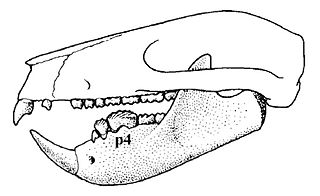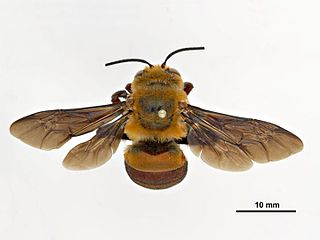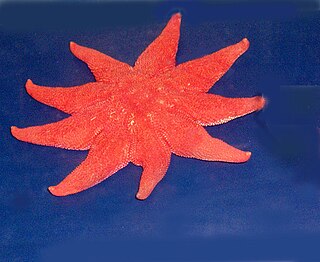
Plagiaulax is a genus of mammal from the Lower Cretaceous of Europe. It was a member of the also extinct order Multituberculata, and shared the world with dinosaurs. It is of the suborder "Plagiaulacida" and family Plagiaulacidae. The genus was named by Hugh Falconer in 1857, and was the first described multituberculate species.

Raptor Red is a 1995 American novel by paleontologist Robert T. Bakker. The book is a third-person account of dinosaurs during the Cretaceous Period, told from the point of view of Raptor Red, a female Utahraptor. Raptor Red features many of Bakker's theories regarding dinosaurs' social habits, intelligence, and the world in which they lived.
Eutropis dawsoni, also known commonly as Gans's grass skink and Gans's mabuya, is a species of lizard in the family Scincidae. The species is endemic to the southern Western Ghats, India.

Charles Dawson was a British amateur archaeologist who claimed to have made a number of archaeological and palaeontological discoveries that were later exposed as frauds. These forgeries included the Piltdown Man, a unique set of bones that he claimed to have found in 1912 in Sussex. Many technological methods such as fluorine testing indicate that this discovery was a hoax, and Dawson, the only one with the skill and knowledge to generate this forgery, was a major suspect.
The New Zealand catshark is a catshark of the family Scyliorhinidae in the order Carcharhiniformes. This species is endemic to in the deep waters around New Zealand. Its length is up to 45 centimetres (18 in). The New Zealand catshark is a small, little-known deep water bottom shark. It is dark brown around the top with a few widely spaced pale spots, and white below. It feeds on bottom-living crustaceans. It is also completely harmless to humans.

Suchosaurus is a spinosaurid dinosaur from Cretaceous England and Portugal, originally believed to be a genus of crocodile. The type material, consisting of teeth, was used by British palaeontologist Richard Owen to name the species S. cultridens in 1841. Later in 1897, French palaeontologist Henri-Émile Sauvage named a second species, S. girardi, based on two fragments from the mandible and one tooth discovered in Portugal. Suchosaurus is possibly a senior synonym of the contemporary spinosaurid Baryonyx, but is usually considered a dubious name due to the paucity of its remains, and is considered an indeterminate baryonychine. In the Wadhurst Clay Formation of what is now southern England, Suchosaurus lived alongside other dinosaurs, as well as plesiosaurs, mammals, and crocodyliforms.

Lasaeidae is a family of very small saltwater clams, marine bivalve molluscs in the order Galeommatida. These bivalves are sometimes called "kelly clams", because one of the genera in this family is Kellia.
Sunstar or Sun Star may refer to:

Microgaza is a genus of sea snails, marine gastropod mollusks in the family Solariellidae.

Amegilla dawsoni, sometimes called the Dawson's burrowing bee, is a species of bee that nests by the thousands in arid claypans in Western Australia. It is a long tongued bee, of the tribe Anthophorini and genus Amegilla, the second largest genus in Anthophorini.

Syngnathus dawsoni is a species of the pipefishes. It occurs in the central, western Atlantic in the Caribbean Sea from Puerto Rico to St. Lucia and has been recorded only from the east of the Mona Passage. It is a marine tropical demersal fish. It is ovoviviparous; the male carries the fertilized eggs in a brood pouch located under his tail. It has been captured at around 7 metres (23 ft) in shallow, inshore water but its habits and ecology are unknown.

Solaster is a genus of sea stars in the family Solasteridae.

Solaster dawsoni, the morning sun star, is a species of starfish in the family Solasteridae. It is found on either side of the northern Pacific Ocean. It has two subspecies:
Chrysotypus dawsoni is a species of moth of the family Thyrididae.

Charles Eric "Chuck" Dawson Jr. was a Canadian-American ecologist, ichthyologist, and taxonomist. He held expertise in gobies, flatfishes, and sand stargazers, and was considered "the ultimate authority" on pipefishes in the family Syngnathidae.
Illaena dawsoni is a species of beetle in the family Cerambycidae. It was described by Breuning in 1970. It is known from Australia.
Rhytiphora dawsoni is a species of beetle in the family Cerambycidae. It was described by Stephan von Breuning in 1970.
Eosentomon dawsoni is a species of proturan in the family Eosentomidae. It is found in Australia.

Melanoplus dawsoni, or Dawson's grasshopper, is a species of spur-throated grasshopper in the family Acrididae. It is found in North America.
















